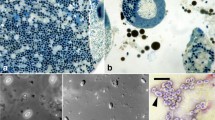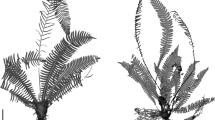Summary
The ultrastructure of three species of microsporidia in winter moths, Operophtera brumata (L.), has been used to consolidate taxonomic assessments previously based on light microscopy. The characters formerly used to assign Nosema operophterae Canning, 1960 to a new genus Orthosoma Canning, Wigley & Barker, 1983, namely that the nuclei are isolated and that sporoblasts are separated from ribbon-shaped multinucleate (2, 4, 8 or rarely 12 nuclei) sporonts, were upheld at the ultrastructural level. Development was in contact with the cell cytoplasm but all stages, which must have included meronts, had an electron dense surface coat. Nosema wistmansi Canning, Wigley & Barker, 1983, was found to be ultrastructurally typical of the genus Nosema Naegeli, 1857. An unusual feature of this species was the close association of cysternae of host endoplasmic reticulum with the surface of meronts, an association lost in sporogony.
Pleistophora operophterae (Canning, 1960) has been transferred, on ultrastructural criteria, to a new genus Cystosporogenes n.g. Nuclei are isolated; all stages develop in a vesicle bounded by an envelope of enigmatic origin; this envelope persists around the spores as a sporophorous vesicle; division of the sporont within this vesicle is by budding and the number of sporoblasts, and therefore spores, is variable up to about 60.
Microsporidia which undergo multisporous sporogony in sporophorous vesicles are now distributed among seven genera. These are: Glugea Thélohan, 1891; Pleistophora Gurley, 1893; Pseudopleistophora Sprague, 1977; Vavraia Weiser, 1977; Baculea Loubès & Akbarieh, 1978; Polydispyrenia Canning & Hazard, 1982 and Cystosporogenes n.g. New genera would appear to be needed for Pleistophora sp. of Sandars & Poinar (1976) and Pleistophora sp. of Percy, Wilson & Burke (1982). ac]19840404
Similar content being viewed by others
References
Canning, E.U. (1960) Two new microsporidian parasites of the winter moth Operophtera brumata (L). Journal of Parasitology, 46, 755–763.
Canning, E.U. (1981) Encephalitozoon lacertae n.sp., a microsporidian parasite of the lizard Podarcis muralis. In. Parasitological Topics. Society of Protozoologists Special Publication No. 1 (E.U.Canning, Editor) Allen Press, Kansas pp. 57–64.
Canning, E.U. & Hazard, E.I. (1982) Genus Pleistophora Gurley, 1893: an assemblage of at least three genera. Journal of Protozoology, 29, 39–49.
Canning, E.U. & Nicholas, J.P. (1980) Genus Pleistophora (Phylum Microspora): redescription of the type species Pleistophora typicalis Gurley, 1893 and ultrastructural characterisation of the genus. Journal of Fish Diseases, 3, 317–338.
Canning, E.U., Lom, J. & Nioholas, J.P. (1982) Genus Glugea Thélohan, 1891 (Phylum Microspora): redescription of the type species Glugea anomala (Moniez 1887) and recognition of its sporogonic development within sporophorous vesicles (pansporoblastic membranes). Protistologica, 18, 193–210.
Canning, E.U., Wigley, P.J. & Barker, R.J. (1983) The taxonomy of three species of microsporidia (Protozoa: Microspora) from an oakwood population of winter moths. Operophtera brumata (L) (Lepidoptera: Geometridae). Systematic Parasitology, 5, 147–159.
Gurley, R.R. (1893) Classification of the Myxosporidia, a group of protozoan parasites infesting fishes. Bulletin of the United States Fisheries Commission for 1891, 11, 65–203.
Loubès, C. & Akbarieh, M. (1978) Etude ultrastructurale de la microsporidie Baculea daphniae n.g., n.sp., parasite de l'épithelium intestinal de Daphnia pulex Leydig, 1860 (Crustace, Cladocère). Protistologica, 14, 23–38.
Lutz, A. & Splendore, A. (1908) Uber pebrine und verwandte Mikrosporidien. Zentralblatt für Bakteriologie, Parasitenkunde, Infektionskrankheiten und Hygiene, Abt. 1 Orig., 46, 311–315.
Percy, J., Wilson, G. & Burke, J. (1982) Development and ultrastructure of a microsporidian parasite in midgut cells of the larch sawfly, Pristiphora erichsonii (Hymenoptera: Tenthredinidae). Journal of Invertebrate Pathology, 39, 49–59.
Purrini, von K. & Skatulla, U. (1979) Über die naturlichen Krankheiten der Frostspanner Operophtera brumata (L) und Erannis defolaria Clerk (Lep. Geometridae) in Spessart, Beyern. Anzeiger für Schädlingskunde, Pflanzenschutz, Umweltschuts, 52, 20–24.
Sandars, R.D. & Poinar, G.O. (1976) Development and fine structure of Pleistophora sp. (Cnidospora: Microsporida) in the mosquito Aedes sierrensis. Journal of Invertebrate Pathology, 28, 109–119.
Sprague, V. (1977) Annotated list of species of Microsporidia. In: Systematics of the Microsporidia, Comparative Pathobiology 2 (L.A. Bulla Jr. & T.C. Cheng. Editors) pp. 31–334.
Szollosi, D. (1971) Development of Pleistophora sp. (microsporidian) in eggs of the polychaete Armandia brevis. Journal of Invertebrate Pathology, 18, 1–15.
Thélohan, P. (1890) Contribution à l'étude des Myxosporidies. Annales de Micrographie, 2, 193–213.
Thélohan, P. (1891) Sur deux Sporozoaires nouveaux, parasites des muscles des Poissons. Comptes Rendus de l'Académie des Sciences, Paris, 112, 168–171.
Thélohan, P. (1892) Observation sur les Myxosporidies et essai de classification des ces organismes. Bulletin de la Société philomatique de Paris, 4, 173–174.
Weiser, J. (1947) Klíč kurčovaní Mikrosporidií. Acta Societatis Scientiarum naturalium Moravicae, 18, 1–64.
Weiser, J. (1977) Contribution to the classification of the Microsporidia. Věstnik Ceskoslovenské zoologické společnosti, 41, 308–320.
Author information
Authors and Affiliations
Rights and permissions
About this article
Cite this article
Canning, E.U., Barker, R.J., Nicholas, J.P. et al. The ultrastructure of three microsporidia from winter moth, Operophtera brumata (L.), and the establishment of a new genus Cystosporogenes n.g. for Pleistophora operophterae (Canning, 1960). Syst Parasitol 7, 213–225 (1985). https://doi.org/10.1007/BF00011452
Accepted:
Issue Date:
DOI: https://doi.org/10.1007/BF00011452




